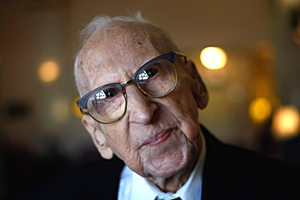How to profit from America’s ageing population
The US population is growing older. Matthew Partridge picks the best way for you to profit.


Virtually every country around the world is getting older or greying', as the current buzz word puts it.
On the one hand, birth rates have been declining as people start families later (if at all) and have fewer children. On the other hand, improved healthcare technology means we're expected to live longer. Experts reckon that one in three people born today will live to be 100.
The trouble is, that doesn't mean that these extra years will all be high quality ones. Science has been great at keeping people alive, but it hasn't been as good at keeping them healthy. Treatments for chronic conditions such as dementia remain elusive.
MoneyWeek
Subscribe to MoneyWeek today and get your first six magazine issues absolutely FREE

Sign up to Money Morning
Don't miss the latest investment and personal finances news, market analysis, plus money-saving tips with our free twice-daily newsletter
Don't miss the latest investment and personal finances news, market analysis, plus money-saving tips with our free twice-daily newsletter
Meanwhile, smaller families are finding it harder to cope. This means there will be more demand for professional carers, particularly in the US.
Here's what that means for investors
America is running out of space for its elderly people
But this is starting to change. The number of over-65s is set to grow by nearly 40% over the next decade.
You could argue that 65 is no longer old' as such after all, Mick Jagger is a sprightly 69 and still performing at Glastonbury. And we can point to plenty of individual examples of people who are lucky enough to stay healthy well into their later years.
But there's no denying that an older population is generally a frailer one. The US Centers for Disease Control estimates that 7% of people in the 65-74-age range have a disability or ailment that limits their day-to-day activities. For those 75 or older this rises to nearly one in five. There are also 2.9 million over-65s with even more acute problems.
So demand for professional care is only likely to grow. But on the supply side, the US care home industry already faces a shortage of spaces.
That's partly because of the financial crisis. As with the rest of the construction industry, firms postponed or cancelled projects as bank funding dried up and investors got cold feet. Five years ago, retirement community construction accounted for over 4.5% of total housing stock for the elderly; now it is less than 1%.
However, it's also to do with changing tastes. In the past, when nursing homes were the exception and stays were relatively short, shared bedrooms were the norm and communal facilities were limited.
Now that people are going to be staying for longer, they (and their families) expect comfortable and pleasant living spaces, with private rooms now considered standard. In the last 15 years, there has also been a big effort to improve the standard of care by clamping down on rogue operators.
On top of that, nursing homes are now often expected to take over many of the after-care functions that hospitals once provided. This makes sense from a financial perspective it can cut costs by 90%. But it does mean that many homes have been forced to upgrade their medical facilities and clinics which clearly costs money.
Because of this, some older homes, especially in poorer areas, have shut down. Others remain but choose to focus on a smaller number of higher-paying customers.
Once you take these closures and capacity reductions into account, the number of facilities and beds in the US has actually fallen. In 2012 there were 1.67 million beds in 15,700 homes, compared with 1.7 million beds in 16,400 homes in 2002.
As a result, older people in some areas, especially cities, face long shortlists. Overall, occupancy rates are at 90%. Evidence suggests that occupancy rates above this level tend to push up margins tremendously.
One way to profit from America's care home shortage
subscribe to MoneyWeek magazine
However, another way to buy into the sector is through Omega Healthcare Investors (NYSE: OHI). Omega builds nursing homes, but then leases them back to the operators. The big advantage of this is that it doesn't get involved in the day-to-day management, which is one of the trickiest parts of the business. It also means that if the management company goes bankrupt, it can find someone to replace them.
Omega has also taken several steps to tackle the remaining risks. It has a large portfolio of 477 facilities in 33 states run by 46 different operators (worth $3.3bn). This prevents it from being too dependent on any individual company, facility or area. It also ensures that those running the facilities have low levels of debt, and are able to pay large upfront deposits.
Finally, the companies have to report to Omega every month, which means that any financial problems are identified early on so they can be dealt with quickly before they escalate. The contracts are clearly written so that the managers are responsible for capital expenditure, taxes and insurance.
The leases are typically multi-year contracts with annual linked increases to account for inflation. Two-thirds of them will continue beyond the end of this decade. Overall, core revenue has been growing quickly at a compound rate of 19% over the past eight years. This allows it to pay a generous dividend of 5.5%, while still keeping debt under control and capital expenditure high.
Our recommended articles for today
For miners, the jig's up
The big rebound for emerging markets
Get the latest financial news, insights and expert analysis from our award-winning MoneyWeek team, to help you understand what really matters when it comes to your finances.

-
 Rightmove: Asking prices set to rise 2% in 2026 after post-Budget market rebound
Rightmove: Asking prices set to rise 2% in 2026 after post-Budget market reboundBuyers and sellers who held off in anticipation of the Budget will come back to the market and contribute to asking prices increasing next year, according to Rightmove
-
 Coreweave is on borrowed time
Coreweave is on borrowed timeAI infrastructure firm Coreweave is heading for trouble and is absurdly pricey, says Matthew Partridge